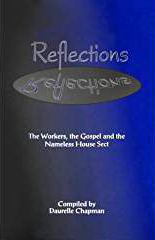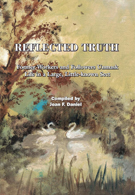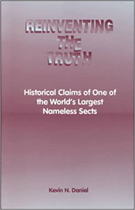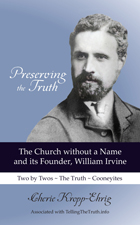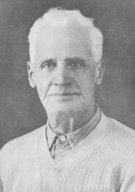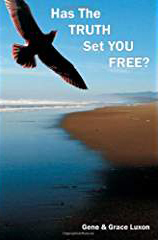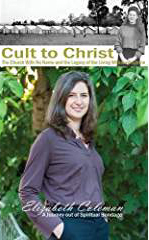The Pioneering Workers
Bethel, South Australia, 1910
List of Bethel Families
The Moravian Brethren
In the years 1848-54 a group of German Moravian Brethren migrated to South Australia and settled at Light Pass. (For a brief history of the Moravian Brethren in Europe see the separate article at the end of this account.) However in 1854 a pastor by the name of Schondorf was sent out by the parent church at Berrnhut in Germany, with the intention of establishing a traditional Moravian Christian commune. He searched until he found suitable land in a district about 80 km north Adelaide, and about 9 km from the town of Kapunda where he bought up 1912 acres. They named the settlement Bethel, from the Bible, meaning "House of God". The centre of the commune was to be one hundred acres of church property which initially was to be governed and managed by the community for the welfare of the church and pastor alike. The Moravians had a great tradition and many quite unique and rather quaint social customs and formalities, and their purpose in forming a farming commune in South Australia was fuelled by the desire for freedom and independence to follow their Christian beliefs and traditions. These people were quite separate from the congregations of the Lutheran pastors Kavel and Fritshe under whom the bulk of the Germans had migrated to South Australia.
In the early days of the commune, with the struggle to establish themselves in this completely virgin settlement, they were very interdependent and the community spirit was high. They worked harmoniously together to build their homes, clear their land, and establish a little village of which the focal point was the Church. As well as the Church there was the Band Hall, for these people had a great culture of fine German and European music and they regularly staged performances and concerts, and those musicians in their band would practice together often, upholding their musical talents as perhaps their greatest possession. As well as the music they had a unique and quaint dressage custom, especially for the women, where a clear distinction was made between the married and the unmarried, or virgins as they were referred to, and also the widows. When a girl turned sixteen she was obliged to always wear some part of her clothing in pink, usually just a scarf or shawl but for special occasions or in church she might wear a dress or blouse in very soft pink shades. The married women would always wear some rich red and could never wear pink, and as can be expected the widows would never wear any bright colours.
The men also paid strict attention to their dress for formal occasions, wearing always black and white with their suits smartly pressed, often with neat black bow ties and on special occasions even top hats and tails. The Moravians also had a number of different ceremonies, one was the coming of age, or debut, for the girls at sixteen and also the young men attaining their majority at 21 years of age. There were many other functions and ceremonies mostly attached to their worship, Christmas and Easter taking the pre-eminence. So it is easy to understand that with their fine rich culture and spirit of harmony and co-operation other families were attracted to them.
All went well for the first twenty years, but in the 1870's a number in the church (of the younger generation it would seem) felt Schondorf was getting too old (he was 60), and they could do with someone with more fluency and style etc. So they wrote to Herrnhut asking for a younger pastor -- without telling Pastor Schondorf. When he found out he objected, refusing to move from the church house because it had been legally signed over to him some years before. The governing committee took him to court but they lost the case, and then to the Supreme Court of South Australia where they lost it again. This brought about a rift in the community. However when the new pastor (Jacobi) arrived in 1876 Schondorf had to move out -- to a cottage he had built himself about half a mile from the church -- and many went to his home for services, but within a year he died a broken man. Pastor Jacobi continued until 1891, when he died. Herrnhut then sent out another man, Pastor Buch and he and his wife taught in the school. However the rift continued, becoming more than he could handle so that in 1906 Herrnhut recalled him saying "You have killed two of our Pastors and we will send no more". So the Committee severed their connection with Herrnhut and in desperation asked the Lutheran Synod to give them a Lutheran Pastor to serve in the Bethel Church. The Lutherans agreed, but many of the Moravians were not happy with the new arrangement. The new pastor (Benman) progressively brought in the trappings and practices of the Lutherans, robes, fees for weddings and funerals etc.
As well as the Moravian Brethren, there had been at Bethel since 1856, a number of people of Wendish origin. They were from Lusatia, a small area in Germany, and had struggled for centuries to maintain their own culture, language and worship although over-ruled by Saxony and Prussia for most of the time. This group had come out to South Australia in 1848, settling at Tanunda, and as they had no pastor, amalgamated with Lutherans whose language they could understand. However in 1856 Peter and George Doecke took up land at Bethel and soon others of their family followed. They joined in worship with the Moravians and their children attended the Bethel school, (German being spoken), but by 1860 this influx was over-crowding both the school and the church. Peter Doecke decided to erect a room on his property for a school, and a bit later two more buildings, one to be used as a church which they called "Steinthal". It had an altar and a pipe organ (donated by Peter Doecke who was the organist), and a choir -- of six! Most of the congregation were Peter Doecke's relatives, and pastors came from neighbouring areas to preach there. They remained on good terms with Pastor Schondorf in his day (he was often a guest preacher) and there was a lot of inter-marrying between the Wends and the Moravians. Both practised infant baptism. In 1906 Peter Doecke died and as numbers at Steinthal had declined the Wendish asked to be amalgamated with the Moravian Church.
By the turn of the century, 1900-1901, the spirit of co-operation and harmony in the community was breaking down. As well as the earlier division over Schondorf, a younger generation had now taken the centre stage. There was a growing disparity between those who had prospered and were gaining their independence and no longer quite as willing to "share all as common", and others who were still struggling to make ends meet. There were many occasions of disruption and disagreement among themselves, and they were jointly disagreeing with their pastor. The atmosphere was such that the House of God could more correctly be described as the House of Strife.
The situation became worse after 1906 when the community was forced to accept the Lutheran pastor. He quickly established himself as an eloquent and powerful preacher, and in fluent, flowing German, practised his oratory on these German-speaking people, as very few of them, especially the older generation, could speak or understand English. But for a number of men and women this preaching was just going over their heads. It did not touch their hearts. One such young couple, amongst others who felt that their original hopes and intentions of a united community were growing dimmer and more hopeless as time went on, was Hermann and Lydia Geue. They felt a lack of fellowship within the congregation and they now had only a superficial relationship within the community. They felt the darkness was closing in and they longed for light. As 1909 wore on, their feeling of need and the distress of all that had disrupted the Bethel community weighed on them and they were searching and praying for light. They did not know that an Irishman and his companion were also praying and searching for them.
Sam Jones heard the gospel in Belfast in 1902 and professed and went out to preach that same year. He was about 25 years of age at the time and prior to this had been a landscape gardener and developed a strong love of nature. He would plant flowers wherever he went and saw the great handiwork of God in nature, which brought out in him a great love for his creator. In 1907 he was moved to come to Australia and on 27th December, 1907, he and a younger companion, Bob Bashford, departed from London and sailed to Australia on the "Orontes". They arrived in Melbourne in February 1908, in time to attend in March the first convention held on Australian soil at Northcote, a suburb of Melbourne.
On 8th April, 1908, Sam Jones and Bob Bashford, together with Tom Turner and Syd Maynard, sailed from Melbourne for Western Australia. It was pioneering days for the gospel there and a very difficult time for them all. Syd had professed there a couple of years earlier when Tom and his companion and two sister workers first came from Ireland, but there had been no other response (maybe one other woman). Modes of transport were poor, they mostly walked, and it was while Sam and Bob were in the Rockingham district forty-five km south of Perth, (the same place where some 38 years later Sam was to die) that Sam's younger companion Bob became very discouraged as they had been told they would get an opening there, but there was none. He said "I cannot continue, I will go back to Ireland," so Sam gave what money he had and continued on alone. Sam, not a strong person, often suffered from ill health, and at this time, after spending several nights sleeping in the open in a dry river bed with no comforts, fell ill and may well have perished had he not been found by some gypsies who nursed him back to health. Sometime later he was able to meet up with Tom Turner and Syd Maynard, the other two brothers in Western Australia.
Early next year (1909) the three brothers in the West came over to the first convention held in South Australia, in March, in the township of Woodside. After this Sam and Syd stayed on, as already in less than nine months, the state had started to show good response to the gospel. Tom Turner went on to Victoria where he spent the year with Willie Hughes around Heidelberg (Melbourne).
It seems Syd and Sam were together after the 1909 convention and worked north from the Adelaide Hills area where the other workers were based. Adam Hutchison was the senior worker in South Australia at that time and we know he and Jim Vallance were in the Adelaide Hills, Harrogate and Mount Torrens localities during 1909. They worked fruitful missions there when such families as the Collinses, Shepherds and Wilsons professed -- also others. We know very little of Sam's movements for the rest of 1909. He was at Mount Crawford in July -- about 40 km north-east of Adelaide. The only other firm data is his own statement regarding one of his first hymns. It was in 1909 in the Gladstone district, about 200 km north of Adelaide, when again unable to get an opening or any response anywhere, that he penned the lines to one of his first hymns, "The Truth of God so Precious", No. 241 in our present book.
As we read the lines of that hymn today we can gauge Sam's feelings at that time: "Though now cast out and suffering", yet he was also able to say, "The lowly way which most despise, I glory now to tread". Throughout the hymn, Sam gives expression to the Love of God that gripped his heart, as well as to his own feeling of need when he says, "As with a contrite heart I walk with Jesus in the way"; and "I never can forsake Him, He is my guide".
Towards the latter part of 1909 the three sets of brother workers in the state swapped companions. Syd Maynard joined Adam Hutchison towards the end of the Harrogate mission, Jim Vallance (previously with Adam) joined Jimmy Gordon who was working further south and Jim Murray (previously with Jimmy Gordon) joined Sam up north. Jim Murray, a New Zealander, had professed in that country in 1906 (while Adam Hutchison was there) and this was his second year in the work having started in Victoria in 1908. He had a brother Archie who was one of the first New Zealanders to go into the work in 1907 and who accompanied Adam, Willie Hughes and Charlie Dubman from New Zealand to Victoria in March that year where these four were effectively the pioneers to that state. (John Hardie and Sandy Alexander had tried it for a short time in 1904, but with no response). Archie went to New South Wales a few years later, left the work, married and had a daughter Dulcie who has preached there (NSW) for many years. His brother Jim also went to NSW from South Australia at the end of 1911.
Coming back to South Australia:
It would seem that Adam Hutchison may have felt Syd Maynard's first 18 months in the work had been discouraging enough so he brought him in on the close of the successful Harrogate mission. Both Jim Vallance and Jim Murray had seen some fruit that year so a change wouldn't do any harm. There was a Christmas meeting that year -- South Australia's first -- at David Wilson's property at Harrogate. We don't know whether Sam and Jim Murray attended this (the change of companions appears to have been earlier, September - October) then returned up north, but the impression is they worked their way south, down the line from Gladstone (sleeping in haystacks!). They alighted the train at Stockport, a small railway siding just 10 km west of Bethel, to make enquiries; each previous mission having proved fruitless, but every one drawing closer to Bethel.
There are some small brown "local" stone railway cottages quite near to the station at Stockport and it was to one of these that Sam and Jim went and knocked on the front door. The lady who answered the door was Mrs. Hermann Matz; Martha, nee Schmidt. Hermann Matz was a builder by trade, and they were only a young married couple at the time, but both had been brought up in, and belonged to, the Bethel community. Martha Matz was able to tell Sam and Jim a little about the trouble at Bethel and how this whole community of German people were fighting amongst themselves. As they stood discussing this a sense of urgency gripped Sam and as Martha Matz was to tell years later, "Sam and Jim just left running", heading up the dusty road towards Bethel. Obviously they were travelling light with little baggage to burden them, and as it must have been past midday Sam was anxious to get there before it was too late to make enquiries about holding gospel meetings in the village.
As they approached Bethel they spotted a man working in his paddock. It was Mr. Hermann Geue, again only a young man, not long married, and he was busy raking straw. He saw Sam and Jim approaching and saw that they were not the swaggy types often seen on the road, so he went to meet them. They introduced themselves and explained that they were looking for a place to hold gospel meetings. Hermann asked who they represented and Sam replied that they represented Jesus Christ and they were preaching the gospel for the love of Jesus and searching for needy souls. This touched a chord in Hermann's heart who saw that these preachers were not preaching for money or material gain as did many of the clergy.
Hermann suggested Sam approach the new minister and ask if they could preach in the church, because he felt if they were preaching only for the love of Jesus they should be given a hearing. He suggested as well that if they could not preach in the church they should ask the man in charge of the band hall, a Mr. Rudolph Schmidt if he could help. The band hall was the main venue for their social gatherings, since their music and band, (with Hermann its leader at that time) was the central attraction at most functions. In their discussions that day Sam must have conveyed the fact that they were finding it very difficult to get an opening anywhere, and perhaps doubted that they would be allowed in, since Hermann said finally, "If they will not allow you into the band hall, then you come and have meetings in our home."
So Sam and Jim Murray approached the Bethel Lutheran pastor. He flatly refused their request to preach in the church, as he felt he was perfectly capable of supplying the spiritual needs of his flock, and it was, of course, unprecedented that an Irishman should come and be allowed to preach to a supposedly tightly-knit German community. The chairman of the band hall, Mr. Schmidt, also refused permission to use that hall, explaining that it was not given out for religious services. So by evening Sam and Jim arrived at Hermann and Lydia Geue’s door, and they opened their home to these two foreign preachers, who were to bring them and many others in that community, the message of the Kingdom of Heaven.
The earnestness of Sam's message spoke deeply to his listeners. Quite a number had accepted the invitation to hear the gospel, so much so that not all could be seated in the main living room. Quite a few sat in an adjoining room, and together with their poor understanding of English as well as Sam's strong Irish brogue, they did not get all the message. So from time to time some of the women would swap around, and on one occasion Martha Matz, for she and her husband and young children were coming across from Stockport, came out and stated to the others there, "We are not saved, no not one of us; we will all need to repent and start anew".
The word that gospel meetings were being held at the Geue's home quickly passed around the district and even further afield, as those attending were diligent in speaking to their friends and relatives about what they were hearing. Hermann and Martha spoke to their brothers-in-law, Walter and Theodore Vogt, both of whom had recently married Martha's sisters, Agnes and Paula respectively. These two young men rode on horseback from Saddleworth to hear Sam and Jim (about 32 km) and this led on to their parents August Vogt and his wife, "Mama and Papa Vogt" as they were known, and their other seven children all attending the meetings. As well, Martha Matz’s brothers, Otto and Friederich Schmidt accepted the invitation, and also a young teenage cousin of theirs, Frieda Schmidt. It was her father who had refused the band hall to the workers. After a few weeks of meetings quite a commotion erupted amongst the Bethel people; some were for God's two servants, Sam and Jim, others were against, so the pastor decided he would act. Without so much as giving the workers a hearing or coming to listen for himself, he let it be known that he was going to hold a special meeting to expose these two imposters.
So he began his service by upbraiding the two foreigners, charging them with being hypocrites of the worst kind, wolves in sheep's clothing who had no other purpose than to tear the Bethel flock apart. Hermann Geue had heard enough, he knew that what the pastor was saying was false. He had seen the spirit of God’s two ministers, heard their words of life that had touched his heart, and begun to meet his need. He jumped up and walked out; and twenty three others followed him. As they went out the door of the Bethel Lutheran church the pastor called after them. "Come back, come back, you poor lost sheep," but they were never to return to that place again. The pastor went on to tell his Congregation that they would all be back within six months, but how mistaken he was!
This very incident brought the situation for the Bethel folk to a
climax
with Sam and Jim. Either that night or just previously Sam had to
tell them that he and his companion would be leaving them (reluctantly)
for a few weeks to attend a "conference" as he put it. This was
to
be the 1910 Convention held on Wuttke's farm at Woodside in April
(according
to one source starting on the 10th -- but this was a Sunday ??).
It appears that Sam was not really ready to test the mission before
convention,
but now the pastor's action had precipitated a situation where
twenty-four
people had broken with their church in a most dramatic way. In
defence
of the workers, these people had put themselves "outside the camp" of
their
own faith and community, and Sam felt he could not deny them
opportunity
to express where their allegiance now lay.
Accordingly that same
night he gave them opportunity to declare their support of the Gospel
that
he and Jim had preached to them, and the same twenty-four raised
hands.
This was in Fred Schmidt's home. It would appear that this stand
was not taken as professing. Sam invited Hermann Geue to attend
the
Woodside convention on Wuttke's farm, and he did so. Mrs. Fred
Payne
(Maggie) of Cambrai, writing to Hermann Geue's son, Clem, (in 1971, who
was preaching the Gospel himself), says how happy she and her husband
were
to see Hermann make a profession by getting to his feet and speaking a
few words at that convention. She says also that he left half way
through to tell the others back at Bethel, and then Otto Schmidt, his
brother
Friederich and Alf Vogt came in his place. Otto professed at that
time also and said later that he came with a list of questions which he
intended presenting to the preachers, but they were all answered before
he had opportunity to do so. These three went home feeling these
people "have it".
Conventions in those days ran for over a week. After convention Sam, this time with a different companion -- Jimmy Vallance from New Zealand, together with two visiting senior workers from Ireland, William Irvine and Wilson McClung (Wilson and his wife Annie had come to Australia at the end of 1908) all returned to Bethel. Sam was a gentle sensitive man, not a powerful speaker, and his listeners were strong stubborn religious Germans. Wilson and William, both very forceful men, probably felt the need to see for themselves that the Bethel folk were really genuine and had properly understood the message. Sam and Jim had a great catch of fish in the net, but it was now necessary to get them into the boat, so the visitors planned to run a special series of gospel meetings for about a week before moving on, these being held in Hermann and Lydia Geue's home. However while Sam was away at convention a further complication had arisen. The young converts had been reading their Bibles and realized that they had never been baptised by immersion. They had only ever been sprinkled on the head when they were about eight days old and could now see that this was not right. They felt they should do something about it, so looked up a Baptist minister and engaged him to baptise them! When Sam and his companions met them they spoke enthusiastically of how they had gone ahead and been baptised. The workers then had the difficult task of telling them that this could not be accepted.
The meetings resumed and went on every night for about a week -- Martha Matz said the purpose of the visit by the two visiting brothers after convention was to confirm the Bethel group, however it is most likely the mission was tested before they left and this was when the remainder of the "twenty-four" made their stand (for the second time!) But during this week while these babes rejoiced in the messages being given, some sensed there was something amiss with brother Irvine. Even Wilson McClung hung his head when William spoke. This impression was further confirmed the following year at the 1911 convention which William Irvine again attended.
After the two visiting workers left, Sam Jones and Jimmy Vallance continued on with the second half of the Bethel mission, and it is apparent that quite a few more were added to the twenty- four, as the list below shows more than thirty. One of things that impressed the Bethel folk, especially Hermann Geue, was Sam's treatment of his young companion who had a difficult delivery and often became tongue-tied, and would lose his train of thought. Sam would suggest he sit down for a while, while they sang a hymn or two and perhaps by then he would be able to gather his thoughts again and continue. This gracious and patient gesture spoke loudly to their listeners. As young Jim would struggle on, they realized it was only because of the love of God that he was urged on to try again. Almost all of the initial group were under the age of thirty; Frieda Schmidt was still in her teens and her parents were hostile and refused to allow her to continue going to meetings. Otto Schmidt would pass on to her what was said in the meetings. She remained a virtual prisoner in her parents’ home for another two years before she was able to leave and fend for herself. At the conclusion of the mission Sam gave those who desired to be baptised by His servants an opportunity, and these he and Jim baptised in the River Gilbert, just a few miles west of Bethel.
Hermann Geue's brother Samuel Geue and his wife Mary and daughter Dora had attended one of the meetings held by two visiting brothers in Hermann's home in the week after convention. They lived some 20 km north-east of Bethel at Bagot's Well, and in June 1910 after the Bethel mission closed, Sam and Jim visited this family and a meeting was held there that evening. Sam Geue wanted to hear more, and on Hermann's suggestion invited the workers to come and stay at his home and hold meetings, which they did and continued on in that district for about six months, in which time San and Mary and Dora made a start. Also about this time Sam and Jim had some meetings in the Saddleworth-Riverton area and William and Mary Phillips heard the message. Mary was exercised and a few weeks after the workers left, wrote to Sam asking could she become part of this. She thus professed and William started a year later. They were the grand-parents of Keith and Rex and also David and Lionel Modra.
About a year after the Bethel mission, Lydia Geue's younger sister Olga Hastings came to work in the Geue's home, and while there had the opportunity to attend gospel meetings, and professed. When she returned home and told her father he responded by writing one of the most hostile letters possible to Hermann Geue, accusing him of breaking up the entire Bethel community, not recognising that it was already falling apart before the Gospel came.
This man forbade his daughter Olga to attend any more meetings, but soon after this two separate tragedies struck his family and he lost two of his sons as a result, after which he relented and allowed Olga to again attend meetings. She became a close friend of Frieda Schmidt after this, and in 1920 Frieda commenced her first year in the harvest field and Olga followed one year later.
In 1924 both Frieda and Olga left our shores to labour in
Germany.
Clem Geue, Hermann’s eldest son who also laboured in the work, had the
privilege to go to Germany in 1976 and bring these two faithful sisters
back to spend their last days in their homeland. Olga died three
months later in January 1977 and Frieda a little over a year later in
February
1978.
.
.
Data for this write-up was taken from a number of sources, and the following items reflect the personal connections of some of the main contributors with members of the Bethel mission.
Some time after professing, Hermann Geue realized that his great passion for music was coming between him and his Saviour, Jesus Christ, so he disposed of all his worldly music and also his trumpet, which he felt had reached the place of becoming an idol to him. He felt they were now excommunicated by family and friends alike in the Bethel community, but they were to go forward into a newer, richer fellowship of love with Christ and his people. The hymn "No Reputation", no 108 in our current book, was written by Sam several years later as an expression of these feelings, set to music written by Hermann, whose tune we still use. Sam was to go on and write over 400 hymns of which we have 90 or so in our present book. Among those who knew him he was aptly referred to as "the sweet psalmist of Israel".
Sam Jones was to say in later years that Martha Matz was his first convert in Australia. Perhaps he felt her heart had been won during that first conversation at the brown stone cottage at Stockport when she opened up and told him of the disunity at Bethel. No doubt Sam observed the way Martha and her husband pursued their mission and so diligently spoke to her brothers and sisters, friends and relatives, urging them to attend these meetings. Possibly she was the first to raise her hand when he tested the meeting that night prior to convention.
Sam had a brother who did not profess and by 1910 this man had acquired some property in Mildura. He was anxious to develop it but was having trouble finding a builder. Sam advised Hermann and Martha Matz of this and, as work was scarce in South Australia, they departed for Mildura taking with them Martha's brothers Friederich (Fred) and Johann (Jack) and their wives Martha (nee Vogt) and Maud. In 1911 Jack and Maud listened to Otto and Fred as they spoke to them about salvation and they made a start. In 1912 Wilson McClung and his wife Annie had a mission in Mildura and confirmed this couple.
In 1922-23 Addie Kuchenmeister and Frieda Schmidt brought the gospel
to the Loechels at Bowhill. In August 1977, fifty-five years
later,
and just a few months before her death, Frieda visited this homestead
again,
on section 7 of Bowhill, and on that occasion related much of what is
contained
in this account, especially regarding the customs of the Bethel
Moravian
Commune. She also spoke about the Bowhill mission of 1922-3.
.
LIST OF BETHEL FAMILIES
A list of the Bethel families including children born later is
below,
with those who professed in 1910 underlined.
An * indicates those thought to have walked out of the church.
Matz: . . . . .*Hermann and *Martha, nee Schmidt.
Children:
Alex, Delores (Dot - Morrison), Wilson.
Geue: . . . . .*Hermann and *Lydia, nee Hastings. Children:
Clem, Wilfred, Gladys and Lorna (Wilson).
Geue: . . . . . Samuel (Hermann’s brother) and Mary.
Children:
Dora, Gertie, Agnes, Alice).
Geue: . . . . . Papa and Mama; Hermann’s parents. They could
not understand English so did not actually profess, but lived peaceably
in Hermann’s home all their lives.
Vogt: . . . . .*August and his *wife; "Papa and Mama", parents of the
Vogts below.
Vogt: . . . . .*Theodore and *Paula, nee Schmidt (Martha Matz’s
sister).
Children: Evangeline (White), Wilfred, Margaret.
Vogt: . . . . .*Walter and *Agnes; nee Schmidt (as above).
Children: Eveline (Harris), Leonard, Ronald.
Vogt: . . . . .*Alfred; went into the work in 1911 and laboured in
the USA, later married.
Vogt: . . . . .*Benjamin;.also went into the work and laboured in NSW
for a time.
Vogt: . . . . .*Gerhardt; known as Gary. Children: Les,
(father to Graham Vogt).
Vogt: . . . . .*Rudolph; known as Rudy.
Vogt: . . . . .*Martha, married Friederich Schmidt soon after the
mission.
Vogt: . . . . .Hilda (aged 13), later married Frank Quick and both
were in the work in New Zealand for a number of years.
Vogt: . . . . .Hettie; later married Harold Wenham of Yankalilla.
Vogt: . . . . .Hertha (aged 9), later married Keith Love of Adelaide.
Schmidt: . . *Otto; aged 21 when he professed, went into the work in
1911 and took the gospel to Germany with Jim Jardine in 1913.
During
World War I he laboured in the USA. He returned to Germany
afterwards,
but his health broke down. He married and returned to Australia
some
years later and settled at Mildura, where his son Mervyn now lives.
Schmidt: . . *Friederich; married Martha Vogt. Children:
Bert, Rhoda and Rhinah (Short).
Schmidt: . . *Frieda. cousin to Otto and Fred. Went in the work
in 1920.
Doecke: . . .*Hermann and *Clara; nee Schmidt. Children:
*Helena, Conrad, Theodore (Ted), Martin, Gerhardt (Gary), Louis.
Jones:. . . . .*May, schoolteacher at Bethel. She later married
Syd Porker of Marama.
Linke: . . . .*Edie, Mrs. Charlie Linke; Charlie did not profess.
Winters: . . *Mabel, didn't continue.
Those to go into the work either directly from the Bethel mission or from later generations are as follows:
Matz: . . . . . Alex (son of Hermann and Martha)
Geue: . . . . . Clem and Gladys (children of Hermann and Lydia)
Geue: . . . . . Dora (daughter of Sam and Mary)
Hastings: . . .Olga -- sister to Lydia Geue.
Schmidt: . . . Otto
Schmidt: . . . Frieda
Vogt: . . . . . .Alfred, Benjamin and Hilda (married Frank Quick, and
both in the work)
Doecke: . . . .Les, Brian, Peter, Lois and Jeanette (grandchildren
of Hermann and Clara, children of Ted)
Doecke: . . . .Robert (grandson of Hermann and Clara, son of Gary)
.
The beginnings of what became known as the Moravian Brethren go back to 1398 when John Hus, as a professor and priest at the University of Prague in Bohemia, preached the beliefs held by Wycliffe in England (whose writings he translated into Czech, the language of Bohemia) and the Waldenses in Europe. He attacked the vices of the clergy and the abuses of the Papal system and defended the supreme authority of the Scripture against church doctrine and tradition. He believed in a return to the simplicity of the Apostolic church and the availability of Scriptures to the common people. In 1415 he was burnt at the stake after being tried and being found guilty of heresy at the Council of Constance. This resulted in thousands leaving the Catholic church and forming a fellowship which met secretly in homes in Bohemia and Moravia. People called them "Unitas Fratum" (United Brethren). Persecution was carried out fiercely against them over the next two hundred years. Some joined the Lutherans in Germany after Luther took his stand in 1521, but the persecution climaxed during the Thirty Years’ War, 1618-48, when, scattered from their homeland they were almost driven to extinction. However a few remained of the "hidden seed" and these maintained their worship in secret and prayed for the restoration of their church.
In 1722 a group led by David Christian found refuge on the estate of Count Zinzendorf in Saxony. Although only 22 years of age, of noble birth and highly educated, Zinzendorf was sympathetic to their plight. He allowed them to set up a community, the United Brethren of Moravia, which was developed on biblical lines with all things in common, living quarters, food, employment and education. They had no priesthood, but elected deacons, bishops and elders. The colony was called "Herrnhut" ("the Lord’s Watch") and became a haven not just for the United Brethren, but for Protestant refugees from all parts of Germany as well as Moravia and Bohemia. In 1727 the whole community decided to accept an apostolic rule drawn up in forty-two statutes.
Zinzendorf became increasingly involved in the affairs of Herrnhut. He first thought the Brethren would become absorbed into the Lutheran church and revitalize it. When this did not happen both the aristocracy and the Lutheran resented Zinzendorf’s committment to the Moravians’ cause, and in 1736 the Saxony court banished him. In exile he established similar settlements in various places in Europe. The Moravian belief was to obey the command "Go ye into all the world" to those who had never heard of Christ, and Zinzendorf travelled extensively visiting Africa, the West Indies, England and North America, together with other Moravian missionaries. John and Charles Wesley, the founders of Methodism in England, were impressed with the Moravians’ fellowship and missionary work. In 1747 the court rescinded Zinzendorf's exile and in 1749 formally recognized the Moravian fellowship of believers. He died at Herrnhut in 1760, by which time the community there had sent out 226 missionaries. This missionary out-thrust continued over the next 100 years.
In the early 1800's a group came out to Australia to try and reach
the
aborigines, however the language was too much of a barrier. In
1848
the first group came to South Australia, and then in 1854 Herrnhut sent
out Pastor Schondorf who was also a teacher and a good, capable
man.
He searched for and found a place suitable for the establishment of a
community,
about 80 km northeast of Adelaide and bought up 1912 acres. They
named the settlement Bethel, and for the first twenty years Schondorf
was
banker, adviser, pastor, teacher and administrator.
Author Unknown
Read additional information re beginning of work in South Australia

 REPRESENTING THE LARGEST COLLECTION OF 2X2 HISTORICAL DOCUMENTS ON THE INTERNET
REPRESENTING THE LARGEST COLLECTION OF 2X2 HISTORICAL DOCUMENTS ON THE INTERNET
 Perry, Oklahoma Conv, 1942
Perry, Oklahoma Conv, 1942
